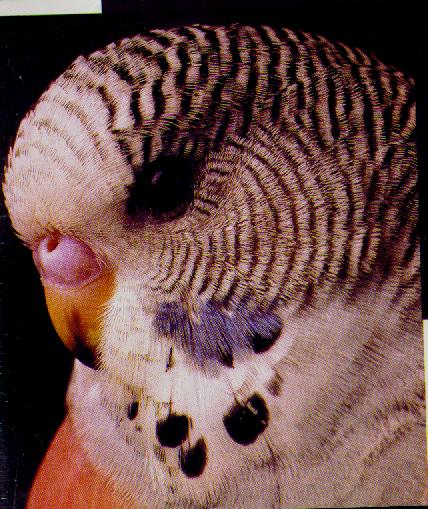

This page is designed to give general information on the pet budgerigar, or the budgie, also known as the parakeet. There is probably some difference between them, but I think it is sufficient enough to call them budgies.:-)
Budgies are originally from Australia. The name "budgerigar" is a name given by the Aborigines which actually means " good to eat " They were eaten by these people, and were brought by white man into Europe and then domesticated. There are still wild budgies in Austraila in the Austrailian inland.
When looking at a juvenille budgie, you should look for the things you look for in every bird. Look for bald patchs, indicating a feather picking problem. Also check dishes to see that the bird is eating. This is difficult to do in the large cages. My recommendation is to use a reputable breeder that can show you more about each bird. Look for one that sleeps on one foot, and wakes up when approached. A young bird should have barring almost all the way to the cere. The cere, the little nostril over the beak, should be a dark violet color with NO discharge. Never be talked into buying a baby with a nut-brown or bright blue cere. These are adult birds. use common sense in determing the health of the bird. Budgies are rather hardy, but any bird can be struck by illness.
Grit, which contains ground minerals, is put into the budgies food in minute amounts. It is supposed to help the bird grind up it's food internally. This is another one of those issues that I would reccomend you speak to the vet about. Hooter and Margarita have not had grit since the first month we got them, because I felt it could do mre har than good. If a bird ingests too much grit, it can stop up the crop, a potentially fatal problem. Again, talk to your vet about your bird, and get a professional opinion.
In budgies it is very easy to tell a male and a female. The female's cere is a deep brown color, and the male is a bright blue color. Don't be concerned however if your budgie looks in between. The cere does not change until usually after the first molt.
In my experience,budgies are hard to tame if there is only one, and practically impossible to tame if there is more than one. If you have more than one budgies, it will be very hard to tame them, and I would suggest looking at The Budgie Chat. There are people who have more knowledge on budgies who can help you better. For one budgie, though, the same rules apply as do with other birds. The best method is to place any kind of birdie treat in the bars of the cage, then, as the bird starts to trust you allow him to get on your finger. This is when the " up " command should be taught. Press lightly on the budgies chest and when he steps on your finger from the perch, say "up". After some time, he will be able to come out of the cage. Which brings us to the next question -->
A huge YES on this one too. Not only does it assure that your bird will stay safe from injury from sporadic flying, but it can also help in the taming process. Clipping a bird's wings is like getting your hair cut, it does not hurt. However, it should be done by a vet or someone who know's what they are doing. Allow them to show you, but before you start, get some cornstarch on hand. A bird has blood feathers that go until a certain point into the feather. If you clip the wing to short, you will clip this feather and cause the bird to bleed. Stopping the bleeding is important, because the budgie is a small animal, and does not have too much blood to lose. After the bleeding stops, continue to watch the bird for awhile to ensure the bleeding does not begin again. Don't let this scare you out of clipping the wings though. A little blood is much better than flying out the door. Most birds don't come back, and it goes unsaid that a domesticated bird could NOT live very long in the wild.
I hope this page ahs been helpful. Again, if you see anything wrong or misinforming, or you just want to give a suggestion on how this page could be better, email me and let me know !
Please send e-mail to :
 This is a healthy six week old budgie. Notice the barring going all the way to the cere, indicating a young bird. Also notice the violet cere. It is a healthy color and also indicates that the bird is young.
This is a healthy six week old budgie. Notice the barring going all the way to the cere, indicating a young bird. Also notice the violet cere. It is a healthy color and also indicates that the bird is young.